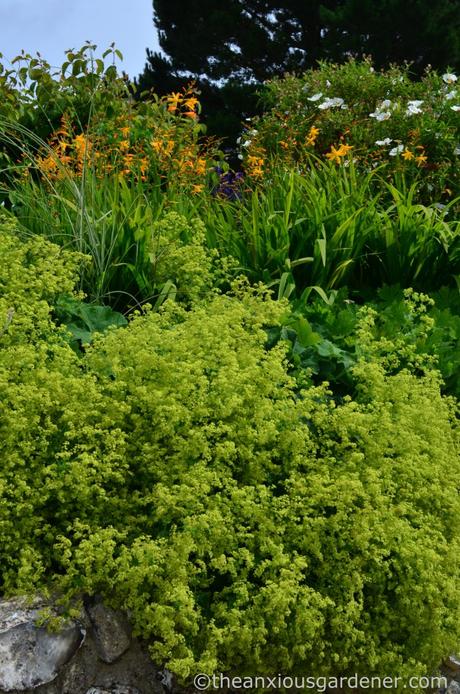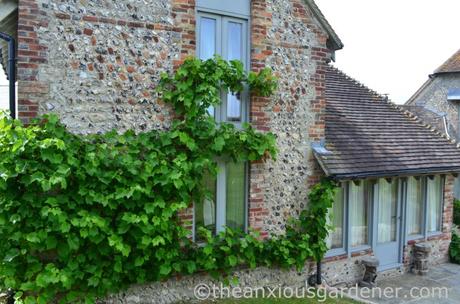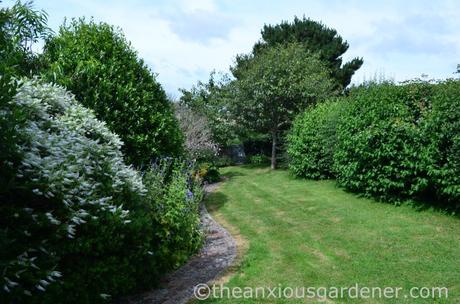I don’t feature The Old Forge very often but not because it isn’t worthy: it’s simply that The Priory is the main star of my blog and a jealous one too. Nevertheless, in late July on my regular Tuesday visit, I took some snaps and thought I’d give you a short – if incomplete – tour of the second garden I tend.

Having entered through the white farm-gate, walked down the drive and past the wisteria covered house (none of which I photographed on this occasion – oops), we pass through an archway beneath outbuildings to arrive at the car-port and parking area. An exciting start. During the six years I’ve worked here, I’ve allowed a massive Virginia creeper (Parthenocissus quinquefolia) to cover walls and buildings; and trained two long tresses to hide the pillars supporting the car-port roof. (It seemed important to do that – I don’t know why).

From inside the car-port you can see just how extensive this plant is and how enormous its reach.

I shall clear growth off the roof before stems wriggle under gaps, swell fat and dislodge tiles. It is a rampant creeper and I regularly cut away unwanted tendrils or the mat of growth that spreads out across the hardstanding (except when I don’t – as in the following photo).

September 2014
I like how the Virginian softens an otherwise sterile car-park and for a short while turns a marvellous, shocking red.

Behind the car-port broods the oil tank on gravel. I wrote about this gravel garden last year.

June 2016
In mid June it was performing rather nicely (for a mainly self-sufficient collection of wholly free plants)

June 2016
and I’d completely forgotten shaking foxglove seed-heads along the base of that wall a couple of summers ago.

In July, with most of the valerian finished and the opium poppies over, crocosmia starts turning the hitherto white and pink scheme orange.

Back to the car-park now and across the main lawn towards the back of the house where a large, new border fronts a paved seating space outside the kitchen door.

I grimly fight rabbits all year-long and this border has been our bloodiest, most contested battlefield. New plants are dug up, fresh growth snipped or chomped at leisure, holes dug often and deep. I commonly see twenty rabbits on arrival and despite my frothing rage they barely bother running for cover.

Who won this protracted struggle? The rabbits of course: they’ve destroyed or seriously diminished several plants in the bed. But I snatched some successes. I protected some new additions with chicken wire: small Rugosa roses for example – though they aren’t visible in these shots. I might remove the wire next year if the roses are big and prickly enough to – satisfyingly – scratch a rabbit’s nose.

Thankfully, Hazel and chums aren’t very interested in sedum and I’m pleased with the amount of bud after my brutal Chelsea chop in early June.

And the Alchemilla mollis here is the frothiest I ever did see.

The rabbits leave this alone too – perhaps it doesn’t taste as good as it looks.

Onwards to the southern end of the house where, six years ago, sat a sad, four-foot high grapevine. I’ve showered this vine with a lot of love over the years and it has generously repaid me.

I’ve erected wires and tied in stems;

and kept it to height that doesn’t make regular pruning too nerve-racking. (I have no head for heights). And it produces very sweet, if small, black grapes too.

June 2016
Turning away from the house, I’ll open a gate and politely nudge you under a rose and honeysuckle arch – this photo from June – into the ‘rabbit-proof-garden’. (I call it this as it is the only part of the grounds fully walled and fenced against the white-bottomed ones … but is it rabbit-proof? No, not really. Baby rabbits squeeze under the gate and adults sometimes hop effortlessly over walls – especially if I chase them).

Another long border here

with Japanese anemones in flower.

Behind those is a once beautiful white lilac … whose branches have now mysteriously died. Shame. I’ll cut away the dead wood this winter and hope that it recovers. There are plenty of new shoots.

Further along the border, past a tall, conical bay tree (quite a big pruning job) and a mixed hedge ripe for cutting (quite a big hedge-cutting job)

is this amazing hebe.

It has a delicious scent and is covered in white flower, butterflies and bees.

I don’t know the variety. It’s about seven feet high and twelve wide. Anyone know what it is? H. salicifolia perhaps?

Still pondering, we finally arrive at the veg garden – only this year, I didn’t grow any. If my rhubarb is a triumph my onions, beans and potatoes struggled with once a week watering; especially in high, very free-draining, sun-baked beds. Short of running a pipe up here and installing a watering system, vegetable growing is hardly worthwhile.

A plastic greenhouse sat here until recently but, battered and partly destroyed by winter storms, I dismantled it. I weed the gravel (but maybe this will be another gravel garden?) and the owner has brought up a chair and table for quiet time – in the company of a fast burgeoning, self-sown milk thistle.

It’s bigger than a dustbin lid and I haven’t the heart to remove it.

Nearby, is an old butler’s sink which lay empty for several years until I filled it with agapanthus. It’s flowering at last and would look smarter still, if the gardener pulled off those dead leaves.

One of many rabbit holes on the lawn, re-seeded and netted against further digging.
So … there you have it: a quick view of The Old Forge garden and grounds (if not the acres of rough grass with mown paths nor the wooded area to the north). I’m only here for 8 hours a week and most of that time I strim and I mow. But I think it looks pretty good for a five acre garden on short hours. I like working here – in the heart of the South Downs – enormously (despite the devastation by rabbits … and a badger). I thought that after over five years it deserved a proper – if very, very belated – introduction.
Save
Save
Save
Save
Save
Save
Save

